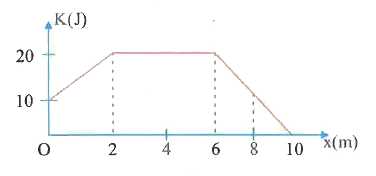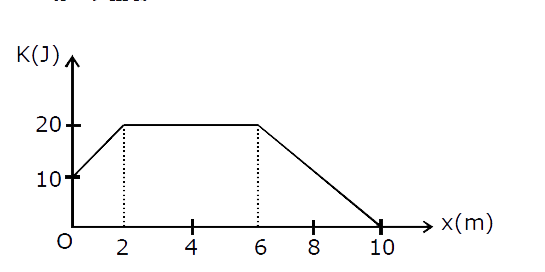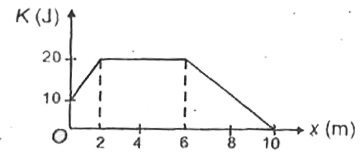Kinetic energy of a particle moving in a straight line is proportional to the time t. The magnitude of the force acting on the particle is :
directly proportional to the speed of the particle
inversely proportional to √t
inversely proportional to the speed of the particle
directly proportional to √t
The correct Answer is:B, C
12mv2∝t
⇒12mv2=kt
∴v=√2ktm
∴ Acceleration =dvdt=√2km.12√1
∴ (B) & (C)
Topper's Solved these Questions
- BOOK - FIITJEECHAPTER - WORK, ENERGY AND POWER EXERCISE - SOLVED PROBLEMS ( OBJECTIVE) ASSERTION REASONING TYPE1videos
WORK, ENERGY AND POWER
- BOOK - FIITJEECHAPTER - WORK, ENERGY AND POWER EXERCISE - COMPREHENSIONS ( Comprehension-I)7videos
WORK, ENERGY AND POWER
- BOOK - FIITJEECHAPTER - WORK, ENERGY AND POWER EXERCISE - SOLVED PROBLEMS (SUBJECTIVE )8videos
WORK, ENERGY AND POWER
- BOOK - FIITJEECHAPTER - TEST PAPERSEXERCISE - PHYSICS747videos
TEST PAPERS
Similar Questions
The position of a particle moving on a straight line is proportional to the cube of the time elapsed. How does the acceleration of the particle depend on time elapsed?
View SolutionKinetic energy of a particle moving in a straight line varies with time t as K=4t2. The force acting on the particle
View Solution
Knowledge Check
- Question 1 - Select One
For a particle moving in a straight line
AIf velocity is negative and acceleration is positive then speed increases.Bif velocity is positive and acceleration is negative then speed decreases.Cif velocity is zero at an instant then acceleration must also be zero at that instant.Dit is possible that speed of a particle is never zero in an interval of time, but average speed is zero. - Question 2 - Select One
If a particle moving in a vertical straight line is
Amoving up and speeding up then its acceleration must be upward.Bmoving up and slowing down then its acceleration must be downward.Cmoving down and speeding up then its acceleration must be downward.Dmoving down and slowing down then its acceleration must be upward. - Question 3 - Select One
A particle is moving along a straight line.
AIf the acceleration of the particle is more than that of another object, the particle is moving faster.BIf the acceleration is positive, the speed must be increasing.CIf the acceleration and the velocity have the same sign, the speed must be increasing.DIf the acceleration is zero, the velocity is constant but the speed may be changing.
The kinetic energy K of a particle moving in a straight line depends on the distances as K=as2. The force acting on the particle is
(where a is a constant)View SolutionThe kinetic energy K of a particle moving along x - axis varies its position (x) as shown in figure.

The magnitude of force acting on particle at x = 9m isView SolutionThe kinetic energy K of a particle moving along x axis varies with its position (x) as shown in the figure. The magnitude of force acting on particle at x = 9 m is -
 View Solution
View SolutionThe kinetic energy K of a particle moving along x - axis varies with its position (x) as shown in figure

The magnitude of force acting on particle at x = 9 misView SolutionIf the kinetic energy of a body is directly proportional to time t, the magnitude of the force acting on the body is
View Solution

